



 Research Summary
Research Summary
Recently, the first ever, space-based droplet combustion experiments were conducted. The Fiber Supported Droplet Investigation (FSDC-1) was part of United States Microgravity Laboratory-2 (USML-2) which was launched on October 20, 1995 on Space Shuttle Columbia mission STS-73.
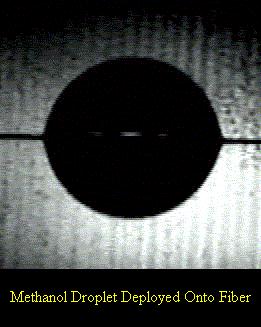
Preliminary results for these experiments, which included methanol, methanol/water mixtures, heptane, and heptane/hexadecane mixtures as fuels have been summarized by Dietrich and co-workers(1996) at the 26th International Symposium. Further numerical modeling and interpretation of experiments involving methanol and methanol/water mixtures (Marchese and Dryer,1996,1997) has been completed which include effects from variations in initial water content and non-luminous flame radiation. Analyses of the experimental data and refinements of models are continuing. Several conclusions are clear presently.
First, water absorption from the surrounding humid environment prior to ignition may cause changes in the initial water content of methanol and methanol/water droplets under the manual experimental procedures. (This problem will not exist in the automated full facility experiment, DCE.) In the FSDC-1 experiments discussed here, these effects are likely to have been present for droplets less than 3.0 mm in initial diameter, and to have been of only minor importance for droplets larger than 4.0 mm in initial diameter.
Secondly, non-luminous radiative losses have major effects on the burning rate and minor effects on flame location for methanol droplet combustion with initial droplet sizes greater than 1mm. Radiation affects the extinction diameter for initial droplet sizes greater than 3 mm. Numerical modeling predicts that for sizes above about 4.5 mm, radiation losses cause the extinction diameter to rapidly increase and the droplet burning time to decrease dramatically with increasing initial diameter. Additional experiments on FSDC-2 will yield further data to test/validate these predicted effects.
Although radiative effects on droplet burning have been studied previously, this is the first data set to test (and modeling result to show) simultaneous, quantitative, time-dependent prediction of burning rate, flame position and extinction diameter where radiation effects should be significant. No model parameter adjustments other than the addition of the radiation loss sub-model (properties taken from the literature) were made to an earlier model (which predicted ground-based, drop tower data) to achieve the level of agreement of numerical predictions with the FSDC-1 experimental data shown below. Modifications have not been pursued to achieve agreement because the FSDC-1 data have significant uncertainties remaining from the presence of the supporting fiber, (uncharacterized) variations in ignition energy, and various, other (manual) operational perturbations. However, the simplicity of the experiment and its ability to obtain initial data for developing more precise experiments using DCE make further flights of FSDC-2 important.
 Introduction
Introduction
The FSDC-1 experiments performed in the MGBX aboard USML-2 in October 1995 yielded the first ever isolated droplet combustion experiments in space. The experiments were very important in helping to improve the design and tests to be performed in DCE and FSDC-2 which are to fly on MSL-1. The entire FSDC-1 experiment was manually operated by members of the crew (Fred Leslie and Kathryn Thornton). The experiments would not have been successful without some important mechanical adjustments of the hardware performed in orbit by Mike Lopez-Alegria. Thus, the success of this particular project was largely dependent on the ability to conduct manned space experiments, as well as the ability of scientists to interact with the experiments in real time over a special data communications links to Marshall Space center called "Hi-Pac". Scientists were able to observe many of the experiments in real-time, and make the necessary adjustments to obtain optimal science.
 The Experiment
The ExperimentIsolated liquid droplets of methanol, two methanol/water mixtures, two n-heptane/hexadecane mixtures, and an n-dodecanol/methanol mixture were burned. Princeton was especially involved in the experiments on methanol and methanol/water mixtures and some current comparisons of data with numerical modeling results generated at Princeton are shown below.
Isolated droplets of 2.0 to 5.0 mm in diameter were manually grown and deployed on small silicon fibers (80 and 150 microns in diameter) and then ignited using two symmetric hot-wire igniters. The igniters were removed from the vicinity of the droplet after ignition, and the droplets were burned in shuttle cabin air (21% oxygen, 39-46% relative humidity, 22-25 C) at atmospheric pressure.
The FSDC-1 combustion module is shown at left. The experiment module consists of a fiber support, deployment needles, hot-wire igniter and fuel accumulators. An electric fan is located at one end of the experiment module to draw in air along the fiber through a metal screen located on the other end of the experiment.
Successful experiments were conducted using methanol, methanol/water, mixtures, methanol/dodecanol mixtures and heptane/hexadecane mixtures in both stagnant and forced convection environments. Shown above is a back-lit image of a methanol droplet during combustion. The back-lighted image of the droplet was video-recorded as a function of time. An approximate "flame position" surrounding the droplet could also be estimated from the video images, since the flame heating caused the supporting silicon fiber to radiate. Data from the video images were then reduced to obtain the square of the droplet diameter, ds, and the ratio of the flame diameter to the droplet diameter, df/ds as a function of time. The data were reduced using imaging and data reduction techniques by NASA-Lewis personnel, and a NASA-Technical will report all test results will appear in mid-1997.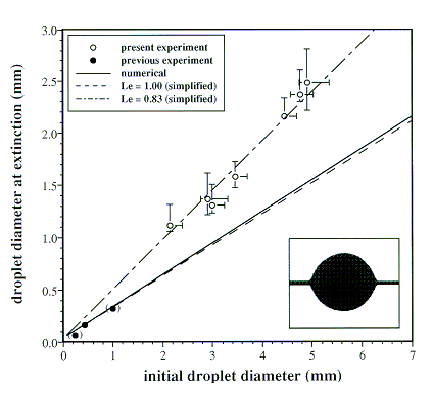
An important effect that has never been observed with such precision on the ground is the so-called "extinction" of the flame surrounding the drop, leaving an unburned liquid drop. The "extinction" diameter of the droplets were very large in these experiments, exceeding the initial size of droplets in ground-based experiments. The extinction diameter was estimated by determining the diameter when the fiber glow ceased, and also from a change in the rate of decay of droplet size with time. Both techniques yield relatively the same value. The extinction diameter data obtained for methanol are shown below.
This figure is from Dietrich and co-workers(1996). The numerical prediction is that obtained without considering non-luminous radiation (discussed below), and the dashed lines are results of rate ratio asymptotic analyses performed at the University of California, San Diego by Zhang and Williams. Note the inserted image of the droplet at extinction. The droplet is not exactly spherical because of the presence of the supporting fiber, and this result causes some inaccuracies in terms of the desired spherical nature of the experiments, particularly for droplets of less than 3.0 mm in diameter. For larger sizes (~4 to 5 mm), the effect of the fiber on drop geometry is negligible.
 Numerical Modeling Results
of FSDC-1 Experiments
Numerical Modeling Results
of FSDC-1 ExperimentsMethanol is a very interesting fuel because:
It is a very simple molecule for which most of the physical, chemical, and thermochemical properties are well known.
Methanol burns without forming soot particles (smoke) which would otherwise complicate the interpretation of the experimental observations. Water, one of the combustion products of methanol, is completely soluble in methanol. That means that although an experiment might begin with an initially pure droplet of methanol, at the droplet burns, water is absorbed by, accumulates within, and is eventually re-vaporized from the drop. The droplet at extinction contains substantial amounts of water.
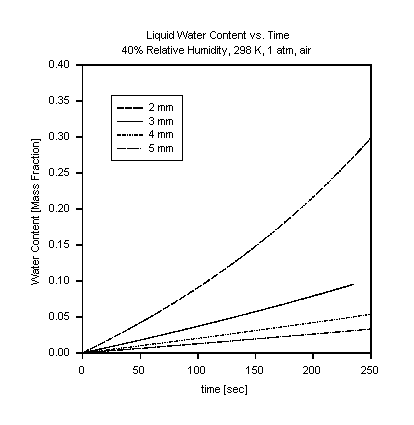 Since the experiments
were conducted manually, the methanol and methanol-water drops
that were studied were exposed to humid air for some time before
they were ignited. Water could be absorbed from the humid air,
raising the possibility that the amount of water within the droplet
may be different at ignition than what was in the liquid used
to form it. Below, is a graph showing how much water would be
absorbed from the quiescent environment (surrounding the drop)
as a function of time.
Since the experiments
were conducted manually, the methanol and methanol-water drops
that were studied were exposed to humid air for some time before
they were ignited. Water could be absorbed from the humid air,
raising the possibility that the amount of water within the droplet
may be different at ignition than what was in the liquid used
to form it. Below, is a graph showing how much water would be
absorbed from the quiescent environment (surrounding the drop)
as a function of time.
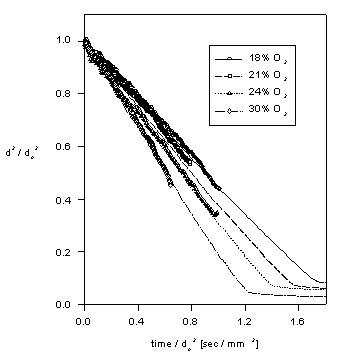
To model the effect of non-luminous radiative heat loss from the droplet flame, the gas phase conservation of energy was modified to include the net radiative heat flux. A Planck-mean absorption coefficient was calculated locally in space and time, from the calculated gas phase temperature and mole fractions of carbon dioxide, water and carbon monoxide. Radiative heat addition at the droplet surface is also included. The differential terms solved in the model are shown in the figure on the left. These equations are solved time dependently using a moving finite element technique. Calculations are performed on workstations and take up to a 100 hours, depending on the initial size of the droplet. calculations are initiated by pre-vaporizing the droplet and then imposing a spherical high temperature "shell" surrounding the drop. The calculation then proceeds through all of the remaining phases of the phenomena until droplet flame extinction occurs.
Prior to adding the radiation effects to the model, calculations were compared extensively with numerous experiments performed in the 2.2 second drop tower at NASA-Lewis. Shown above right, are comparisons with experimental burning rate for several different levels of oxygen in the surrounding nitrogen (at one atmosphere pressure).
The following three figures show comparisons of calculated droplet diameter-squared, burning rate, and flame position as a function of time (with and without the inclusion of radiation effects) with data from FSDC-1. Note that without including radiation, the droplet history is not predicted well for both pure methanol and initial water/methanol cases. The second figure shows that the burning rate is overestimated when radiation is not considered. The third figure shows comparisons of the measured and predicted flame position as a function of time (with radiation included) Of all of the parameters compared, the predicted flame location is the least affected by radiation.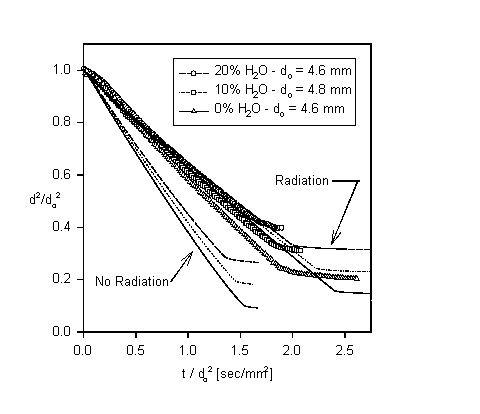
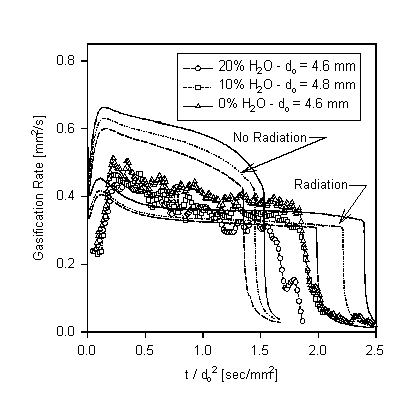
The final two figures show the extinction diameter and burning rate as a function of the initial diameter. The first figure shows that the burning rate is experimentally observed to decrease with increasing initial diameter. Numerical computations without radiation predict that the burning rate is not a function of droplet size. Both experiment, and calculations including radiation show that burning rate is affected by radiation at initial drop diameters as small as 1.0 mm. The final figure compares measured droplet extinction diameter for methanol and methanol/water experiments with calculations which include radiation. The various lines assume different amounts of water (% by mass) in the initial droplet. Note that the agreement is substantially improved over that shown above by including radiation. As noted earlier, some of the experiments may have had more water than expected due to absorption of water from the humid, surrounding atmosphere. This problem should have been more important for small, pure methanol drops(less than 3.0 mm) and should have been of little significance for all drops studied that were initially larger than 4.0 mm. The effects of the silicon filament not accounted for in the spherical theory nor in heat transfer effects included in the models. These effects will also be most significant at small drop sizes.
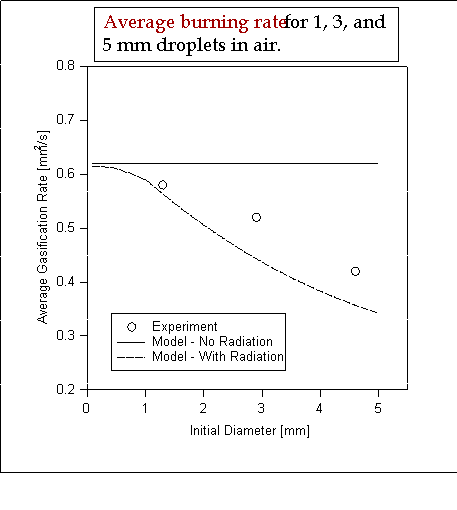
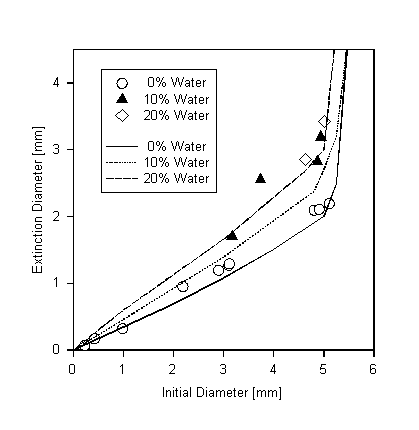
Science Support for Space-Based Droplet Experiments
The experiments and modeling conducted in the Laboratory of Prof. Dryer at Princeton provide scientific support for droplet combustion research in conducted at NASA-Lewis Research Center in the 2.2 second and ZGF 5.18 second droptowers, as well as aboard the Space Shuttle. The first type of shuttle experiment is termed the Fiber Supported Droplet Combustion(FSDC) Experiment. This experiment is designed to be operated within the Glove Box Facility. The FSDC experiment was first flown as FSDC-1 aboardUnited States Microgravity Laboratory-2 (USML-2) launched on October 20, 1995 on Space Shuttle Columbia mission STS-73. A second fiber-supported droplet combustion experiment, FSDC-2,was to operate on Microgravity Science Laboratory-1 (MSL-1), launched aboard STS-83 Space Shuttle Columbia mission launched April 4, 1997. However, the mission was curtailed from 16 days to approximately 5 days by malfunction of one of three fuel-cell systems aboard the orbitor. The operation of this experiment was precluded altogether by the shortened mission.
The second type of Shuttle experiment supported by Princeton is called the Droplet Combustion Experiment (DCE). The first flight of this facility experiment was as part of MSL-1 aboard the STS-83 launched April 4, 1997. This experiment successfully operated during the curtailed mission to achieve the first observations of free-floating, isolated droplet combustion in space. A re-flight of this mission is presently scheduled for July 1, 1997.
A re-flight of the MSL-1 mission was launched July 1, 1997. As of the update of this page, both FSDC-2 and DCE experiments are operating well. Over twenty five successful FSDC-2 experiments have been performed thus far, using methanol, 30% water/70% methanol, 15% water/85% methanol, ethanol, 4% water/ 96% ethanol as fuels. More than 20 DCE experiments have been performed with a about the expected probability of success (> 50%). See the STS-94 Summary Page for further information.
Future flights of both experimental configurations for studying droplet combustion are currently being planned, and droplet combustion research is also continuing in the NASA-Lewis drop towers.
Return to Microgravity Droplet Combustion Home Page
http://www.princeton.edu/~fldryer/nasa.dir/current2.htm
Last updated: April 18, 1997